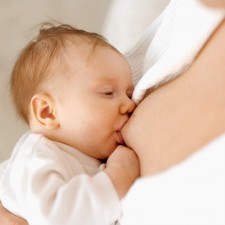วัตถุประสงค์ของหัวข้อการเรียน
??????????? เมื่อสิ้นสุดการเรียนรู้แล้ว ผู้รับการฝึกอบรมสามารถ
??????????? 1.บอกขอบเขตของข้อมูลที่จำเป็นต้องอภิปรายกับหญิงตั้งครรภ์ (20 นาที)?????????????????
??????????? 2.บอกสิ่งที่จะต้องเตรียมเต้านมระหว่างการตั้งครรภ์สำหรับการให้นมแม่ วิธีใดมีหรือไม่มีประสิทธิภาพ (5 นาที)?????????????? ???????????????????????????????????????????????????????????????????????????????????
??????????? 3.บอกได้ว่า หญิงตั้งครรภ์คนใดต้องการการดูแลเพิ่มเป็นพิเศษ (5 นาที)????????????????????
??????????? 4.บอกขอบเขตของข้อมูลที่จำเป็นต้องอภิปรายกับหญิงตั้งครรภ์ที่ติดเชื้อเอชไอวี (10 นาที)
??????????? 5.ฝึกทักษะการสื่อสารที่จะใช้กับการอภิปรายเรื่องการเลี้ยงลูกด้วยนมแม่กับหญิงตั้งครรภ์ (50 นาที)
??????????? รวมเวลาทั้งสิ้น 90 นาที
วัสดุอุปกรณ์
??????????? -สไลด์สอนมารดาที่คลินิกฝากครรภ์
??????????? -สไลด์ข้อแนะนำเกี่ยวกับหญิงตั้งครรภ์ที่ติดเชื้อเอชไอวี
??????????? -ข้อมูลวิธีการให้คำปรึกษาและการตรวจทางห้องปฏิบัติการสำหรับการติดเชื้อเอชไอวีในสตรีตั้งครรภ์
??????????? -ข้อมูลวิธีการให้คำปรึกษาเรื่องการเลี้ยงลูกด้วยนมแม่ในหญิงตั้งครรภ์ที่มีการติดเชื้อเอชไอวี
??????????? -รายการการตรวจสอบสำหรับสตรีที่ฝากครรภ์
??????????? -กิจกรรมทางเลือก ได้แก่ ค่าใช้จ่ายในการเลี้ยงลูกด้วยนมผสม (ควรหาข้อมูลก่อนการเริ่มกิจกรรมการเรียนรู้)
ข้อมูลที่ควรอ่านเพิ่มเติมสำหรับผู้ให้การฝึกอบรม
-The optimal duration of exclusive breastfeeding. Report of an expert consultation. Geneva, WHO. March 2001.
-The optimal duration of exclusive breastfeeding, A systematic review WHO/FCH/CAH/01.23
-Butte, N et al, (2001) Nutrient Adequacy of Exclusive Breastfeeding for the Term Infant during the First Six Months of Life. WHO, Geneva.
-Diet, Nutrition and the Prevention of Chronic Diseases. Report of a Joint WHO/FAO Expert
Consultation. Geneva, WHO Technical Report Series, No. 916.
-HIV and Infant Feeding Counselling : a training course WHO/UNICEF/UNAIDS, 2000.
-Integrated Infant Feeding Counselling: a training course WHO/UNICEF, 2005.
-UNAIDS/UNICEF/WHO. HIV and Infant Feeding: Framework for Priority Action (2003).
HIV and Infant Feeding – Guidelines for decision-makers (updated 2003).
A guide for health care managers and supervisors (updated 2005).
A review of HIV transmission through breastfeeding (updated 2007).
-WHO/UNICEF/USAID. HIV and infant feeding counselling aids (2005).
Counsellors using the tools should have received specific training through such courses as the
WHO/UNICEF Breastfeeding Counselling: A training course and the WHO/UNICEF/UNAIDS HIV
and Infant Feeding Counselling: A training course, or the “Infant and Young Child Feeding
Counselling: An integrated course”. The tools consist of the following parts:
– A Flipchart (ISBN 92 4 159249 4) to use during counselling sessions with HIV-positive
pregnant women and/or mothers.
– Take-home flyers. The counsellor should use the relevant flyer, according to the mother’s
decision, to teach the mother, and she can then use it as a reminder at home.
– A Reference guide (ISBN 92 4 159301 6) that provides more technical and practical
details than the counselling cards. Counsellors can use it as a handbook.
-Guiding principles for feeding infants and young children during emergencies. Department of
Nutrition for Health and Development, WHO 2003.
-Infant Feeding in Emergencies. Nutrition Unit, WHO European Office 1997.
-Infant Feeding in Emergencies, Module1, Emergency Nutrition Network. http://www.ennonline.net/
Additional information related to risks of formula use:
-Guidelines for the safe preparation, storage and handling of powdered infant formula. Food Safety, WHO (2007).
_ How to Prepare Powdered Infant Formula in Care Settings
_ How to prepare formula for use at home
หนังสืออ้างอิง
1.????? WHO/UNICEF. BFHI Section 3: Breastfeeding promotion and support in a baby-friendly hospital ? 20-hour course. ?2009

